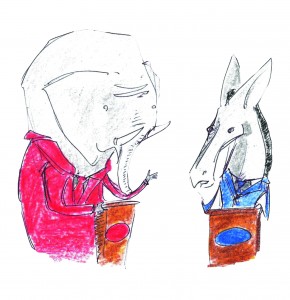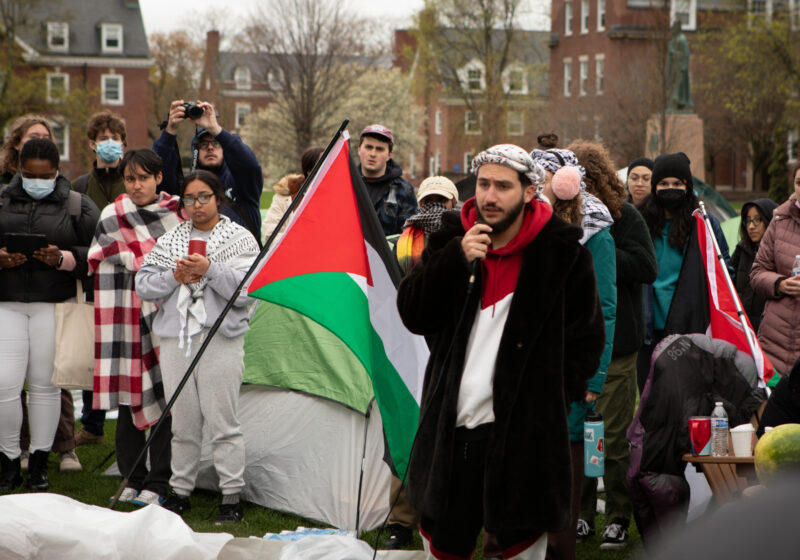With Election Day less than three weeks away, the democratic and republican parties have been warming up the podiums at the televised debates that have come to characterize modern elections. Taking advantage of the final opportunities to win over voters, based largely on the massive publicity surrounding the event, the candidates have come prepared with statistics, plans, dramatic closing statements and a generous amount of mudslinging.
Although the debates, and many of the discussed issues, seem far removed from our campus, many political student groups have been actively participating in the political process.
A wide array of issues were discussed at the first presidential and vice-presidential debates as well as at the second presidential debate on Oct. 16.
To help students cast informed votes on Nov. 6, here is a rundown of the competing views on the major issues — from both candidates and students.
Job Creation
While President Barack Obama touted the success of his administration at creating five million private sector jobs in the last 30 months, he also pointed out that further improvement in the job market would require investing in education, training and new sources of energy, amending the tax code to help small businesses and companies that are investing in the United States and reducing the deficit in a balanced way.
Former Governor Mitt Romney’s response was a five-point plan that Representative Paul Ryan would reiterate in his own debate — energy independence, improving trade, ensuring workers have the skills they need, balancing the budget and championing small businesses.
Sophomore Ryan Dickey sees a connection between jobs and taxes on businesses.
“The more money businesses can keep, the more jobs they can create,” he said.
Taxes
All four men were in favor oftax relief for the middle class. The point of contention was how to tax small businesses (the wealthy were also an issue, but took a backseat).
Vice President Joe Biden lamented that there is a “different set of rules for Wall Street and for Main Street,” echoing Obama’s example of corporate welfare for the oil industry. He took issue with Romney’s definition of small business, which he said was broad enough to include hedge funds, as well as with carried interest and capital gains loopholes that favor those with high incomes.
Ryan reiterated Romney’s championing of small business. He felt that Obama’s plan to take as much as 44.8 percent of small business income in taxes, in contrast with the current 28 percent was excessive. He also stated that there are not enough small businesses and wealthy people for Obama’s tax plan to work; instead, he and Romney offered the solution of lowering tax rates but denying loopholes and deductions to high-income taxpayers.
Sophomore Alex Montes highlighted the relationship between taxes and government programs.
“I don’t know how people can want less taxes and more government programs,” he said. “If you want a good education and efficient health care programs, you need taxes.”
The Deficit
Obama pegged the origins of the $1 trillion deficit as “two wars paid for on credit card,” an economic crisis and inefficient government programs. To combat the deficit, he pointed out, his administration has cut 95 ineffective government programs, $50 billion of medical fraud waste in Medicare and $1 trillion in the domestic discretionary budget. He also referred viewers to his website, on which a $4 trillion deficit reduction plan cuts $2.50 for every $1 it asks for in revenue.
Romney expressed moral issue with passing the deficit on to future generations and discussed two ways to deal with this: encourage economic growth, which goes back to the issue of job creation, and lower spending, mainly by asking the question, “Is the program so critical that it’s worth borrowing money from China?” Romney plans to send programs to states as well as cut funding for Obamacare, PBS and redundant government agencies.
Dickey had an issue with some of the Democratic budget plans.
“Obama’s wish to raise the debt ceiling won’t decrease the deficit,” he said.
Entitlements
(Medicare & Social Security)
Obama and Biden were firm on the position that they would not privatize Social Security or Medicare. As opposed to government, Obama said, private companies are after profit. He also stated that Social Security is structurally sound but just needs some tweaking. Obama and Biden both brought up how their administration saved $716 billion through Medicare efficiency and lowered drug costs for seniors by regulating insurance companies and provider payment.
The Romney-Ryan ticket, on the other hand, claimed that Medicare and Social Security need adjusting. They proposed changing the program for those aged 54 and below — but not for current or near-retirees — to guaranteed coverage options for which Medicare would subsidize the premiums.
Montes felt that this should be a bigger issue in this year’s election than it is shaping up to be.
“It’s crazy to me how older Americans compose most of Romney’s support when he plans to cut their health care entitlements and benefits,” he said.
Health Care
Obama defended the Affordable Care Act (Obamacare) by stating that it is “part of making sure middle class families are secure in this country.” He continued by explaining how it keeps patients with their doctors and insurance plans, but provides protection from insurance companies. It also allows children to stay on their parents’ insurance until age 26, mandates rebates if insurance companies are not spending enough on care and sets up group plans in which rates are typically 18 percent lower than for individual plans. Ironically, he pointed to Romney’s state of Massachusetts to model the success of such a plan. He also used the Cleveland Clinic as an example of how to provide great care at a lower than average cost.
Romney turned this example against Obama, saying that the Cleveland Clinic is a case in point for keeping health care privatized, as the private market is what fosters creativity and innovation in lowering costs. He wants to repeal Obamacare mainly because it is expensive and he thinks it will cause small businesses to hire less workers. Romney plans to focus on state-level programs, as he did in Massachusetts, and then bring down costs. He deigned to give other specific details but explained that he feels there are different ways to reach the same end and he is open to input from both democrats and republicans in Congress.
Senior Liz Palais does not support Obamacare.
“I don’t think that Obamacare is the right solution to such a complex issue,” she said.
The debates addressed many more issues, including the role of government and foreign policy. Each candidate brought a unique personality to the stage, reflected in the tones of each debate.
Obama closed the first debate by reaffirming his faith in the American people, promising that he “[fights] every single day on behalf of the American people, the middle class” and promising to continue that fight in a second term. Biden echoed this sentiment in his first closing statement, lowering his voice as he explained his purpose as “leveling the playing field for the middle class.”
Ryan stressed the distinction between an economy under Romney or Obama and asked Americans to consider what kind of country they want to be a part of. Romney ended by pointing out the paths America could take under different leadership and claimed he would “keep America strong and get America’s middle class working again.”
Both sides threw out plenty of statistics and studies to support their statements and plans. But, as Romney pointed out, for every one study supporting a hypothesis there are six studies disproving it.
Senior Greg Werbin agrees.
“I thought the debates were a hilarious circus,” he said.
The real debate is between the ways each candidate views government and its role. It is up to the citizens of the United States — and the students of UR — to carefully review the ideals and policies of both candidates and make an educated choice on Election Day.
Sarraf is a member of the class of 2015.



